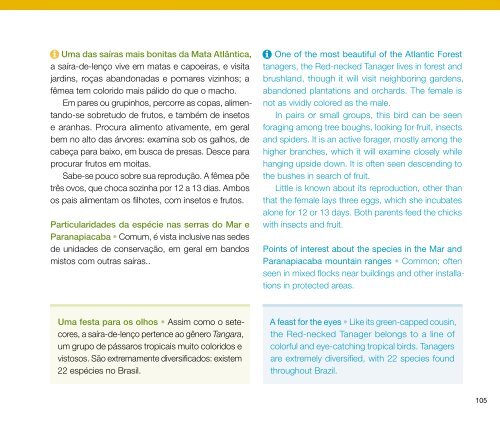Guia de aves Mata Atlântica Paulista - Secretaria do Meio Ambiente
Guia de aves Mata Atlântica Paulista - Secretaria do Meio Ambiente
Guia de aves Mata Atlântica Paulista - Secretaria do Meio Ambiente
Create successful ePaper yourself
Turn your PDF publications into a flip-book with our unique Google optimized e-Paper software.
Uma das saíras mais bonitas da <strong>Mata</strong> <strong>Atlântica</strong>,<br />
a saíra-<strong>de</strong>-lenço vive em matas e capoeiras, e visita<br />
jardins, roças aban<strong>do</strong>nadas e pomares vizinhos; a<br />
fêmea tem colori<strong>do</strong> mais páli<strong>do</strong> <strong>do</strong> que o macho.<br />
Em pares ou grupinhos, percorre as copas, alimentan<strong>do</strong>-se<br />
sobretu<strong>do</strong> <strong>de</strong> frutos, e também <strong>de</strong> insetos<br />
e aranhas. Procura alimento ativamente, em geral<br />
bem no alto das árvores: examina sob os galhos, <strong>de</strong><br />
cabeça para baixo, em busca <strong>de</strong> presas. Desce para<br />
procurar frutos em moitas.<br />
Sabe-se pouco sobre sua reprodução. A fêmea põe<br />
três ovos, que choca sozinha por 12 a 13 dias. Ambos<br />
os pais alimentam os filhotes, com insetos e frutos.<br />
Particularida<strong>de</strong>s da espécie nas serras <strong>do</strong> Mar e<br />
Paranapiacaba • Comum, é vista inclusive nas se<strong>de</strong>s<br />
<strong>de</strong> unida<strong>de</strong>s <strong>de</strong> conservação, em geral em ban<strong>do</strong>s<br />
mistos com outras saíras..<br />
One of the most beautiful of the Atlantic Forest<br />
tanagers, the Red-necked Tanager lives in forest and<br />
brushland, though it will visit neighboring gar<strong>de</strong>ns,<br />
aban<strong>do</strong>ned plantations and orchards. The female is<br />
not as vividly colored as the male.<br />
In pairs or small groups, this bird can be seen<br />
foraging among tree boughs, looking for fruit, insects<br />
and spi<strong>de</strong>rs. It is an active forager, mostly among the<br />
higher branches, which it will examine closely while<br />
hanging upsi<strong>de</strong> <strong>do</strong>wn. It is often seen <strong>de</strong>scending to<br />
the bushes in search of fruit.<br />
Little is known about its reproduction, other than<br />
that the female lays three eggs, which she incubates<br />
alone for 12 or 13 days. Both parents feed the chicks<br />
with insects and fruit.<br />
Points of interest about the species in the Mar and<br />
Paranapiacaba mountain ranges • common; often<br />
seen in mixed flocks near buildings and other installations<br />
in protected areas.<br />
Uma festa para os olhos • Assim como o setecores,<br />
a saíra-<strong>de</strong>-lenço pertence ao gênero Tangara,<br />
um grupo <strong>de</strong> pássaros tropicais muito colori<strong>do</strong>s e<br />
vistosos. São extremamente diversifica<strong>do</strong>s: existem<br />
22 espécies no Brasil.<br />
A feast for the eyes • Like its green-capped cousin,<br />
the Red-necked Tanager belongs to a line of<br />
colorful and eye-catching tropical birds. Tanagers<br />
are extremely diversified, with 22 species found<br />
throughout Brazil.<br />
105

















